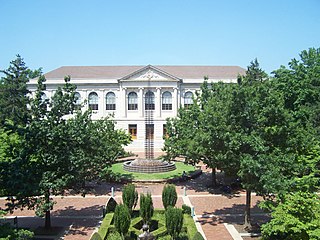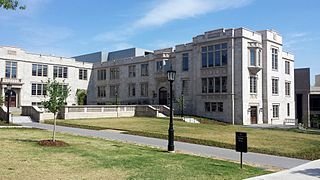
The University of Arkansas is a public land-grant, research university in Fayetteville, Arkansas. It is the flagship campus of the University of Arkansas System and the largest university in Arkansas. Founded as Arkansas Industrial University in 1871, classes were first held on January 22, 1872, with its present name adopted in 1899. It is noted for its strong programs in architecture, agriculture, communication disorders, creative writing, history, law, and Middle Eastern studies, as well as for its business school, of which the supply chain management program was ranked the best in North America by Gartner in July 2020.

The Pentacrest is the Old Capitol and a collection of four buildings on the campus of the University of Iowa that surround the Old Capitol — Jessup Hall, Macbride Hall, MacLean Hall, and Schaeffer Hall — on a four-block-sized parcel of land in Iowa City, Iowa. The Old Capital exhibits the Greek Revival style while the four buildings that surround it display Beaux-Arts architecture.

The Manhattan Construction Company is an American-owned construction company founded by Laurence H. Rooney in Chandler in Oklahoma Territory in 1896. Today, the firm operates under its parent company, Manhattan Construction Group with affiliates Cantera Concrete Co. and Manhattan Road & Bridge. Manhattan Construction Group is recognized by Engineering News-Record as a top general builder, green builder and bridge builder in the nation. In 2013 and 2012 Manhattan has received more than 50 industry honors for quality and safety. The company's services include "Builder-Driven Pre-Construction", construction management, general building, design-build and turn-key projects, and roads, bridges and civil works. The company works in the U.S., Mexico, Central America and the Caribbean. Not to be confused with Manhattan Construction of Durham Region.

The Iowa Old Capitol Building is located in Iowa City, Iowa, United States. It was once the main government building for the state of Iowa, and it now stands as the most prominent landmark at the center of the University of Iowa's campus. The building was depicted on the 1946 Iowa Centennial commemorative half dollar. It was individually listed in the National Register of Historic Places (NRHP) in 1972, and it was named a U.S. National Historic Landmark in 1976. In 1978 it was included as a contributing property in the Pentacrest, a historic district listed on the NRHP.

Fort Logan H. Roots was a military base located in North Little Rock, Arkansas, set on a high promontory overlooking the Arkansas River. The land was traded to the Federal Government in 1892 in exchange for the property now known as MacArthur Park, in Little Rock, which had been a military arsenal since the 1830s when Arkansas was a territory. The base was named for Congressman Logan H. Roots in recognition for his work in the negotiations.

The University of Arkansas Campus Historic District is a historic district that was listed on the National Register of Historic Places on September 23, 2009. The district covers the historic core of the University of Arkansas campus, including 25 buildings.

Vol Walker Hall is a building on the University of Arkansas campus in Fayetteville, Arkansas. It contains the Fay Jones School of Architecture and Design. The structure was added to the National Register of Historic Places in 1992.

Gearhart Hall at the University of Arkansas is a building on the University's campus in Fayetteville, Arkansas. The building was added to the National Register of Historic Places in 1992.

Peabody Hall is a building on the University of Arkansas campus in Fayetteville, Arkansas. The 1913 structure is a contributing property to the University of Arkansas Campus Historic District, which is listed on the National Register of Historic Places. Peabody Hall has continuously housed the teacher education department since completion in 1913. Today, the department is part of the University of Arkansas College of Education and Health Professions. It was built using private funds from George Peabody, one of the fathers of modern philanthropy.

Galloway Hall is a residence hall on the campus of Hendrix College in Conway, Arkansas. It is a large Tudor Revival three story brick building, designed by architect Charles L. Thompson and built in 1913. Its central portion has a gabled roof, with end pavilions that have hip roofs with gabled dormers, and stepped parapet gables, with limestone trim. It is the oldest dormitory building on the campus. It was named to honor Bishop Charles Betts Galloway.

Stockton Hall is a building on the campus of George Washington University in Washington, D.C.. It was listed on the District of Columbia Inventory of Historic Sites in 1987 and on the National Register of Historic Places in 1991.

The Lane Hotel is a historic former hotel building in Rogers, Arkansas, United States. It is a five-story yellow brick Spanish Revival building, designed by architect John Parks Almand and completed in 1929. It is the largest Spanish Revival building in Arkansas, with a prominent colonnade of arches at the second level, above a first floor series of commercial storefronts, and a central tower. The hotel was not successful, having been completed just at the outset of the Great Depression, and went through a succession of owners before closing in 1965. Beginning in 1999 it was a retirement community known as Peachtree on the Lane

The Cross and Nelson Hall Historic District encompasses two historic buildings on the campus of Southern Arkansas University in Magnolia, Arkansas. Cross Hall and Nelson Hall were both built in 1936 by the Public Works Administration (PWA) as dormitories for boys and girls, respectively. They are two-story L-shaped brick buildings with Colonial Revival and Collegiate Gothic stylistic elements. Cross Hall has since been converted into classrooms and professors' offices; Nelson Hall now houses student services and the admissions office.

Pattie Cobb Hall, is an historic academic building on the campus of Harding University in Searcy, Arkansas. It is a large three-story Colonial Revival structure, built out of reinforced concrete faced in brick. Its flat roof is encircled by a low balustrade, and a four-column portico projects from the front. The hall was built in 1919, and is one of two buildings surviving from the time when this campus was home to Galloway Female College. That school closed in 1933, and its campus was purchased by Harding the following year.

Parnell Hall is the central building of the campus of the Arkansas School for the Deaf on West Markham Road in Little Rock, Arkansas. It is a large 2-1/2 story Classical Revival building, designed by Francis, J. Erhart and completed in 1931. The school has long been the central educational facility for Arkansas's deaf population, with Parnell Hall playing a central role, providing classrooms, administrative facilities, and a large meeting hall.

Ellis Hall is an administration building on the campus of Hendrix College in Conway, Arkansas. It is basically a large two-story house, with Craftsman styling, built in 1913 to a design by Charles L. Thompson, who also designed several other buildings on the Hendrix campus. The building served as the college's President's House until 1980, and now houses the college's admissions and financial aid offices.

Caraway Hall is a historic dormitory building on the campus of Arkansas Tech University in Russellville, Arkansas, USA. It is a brick building with Colonial Revival styling, built in 1934 with funding from the Federal Emergency Administration of Public Works, later known as the Public Works Administration. It is roughly H-shaped, with a central three-story section with a gabled roof and end chimneys, which is flanked by two-story flat-roofed wings, one longer than the other.

The Hugh Roy and Lillie Cullen Building is the central administration building of Southwestern University in Georgetown, Texas. Completed in 1900, the Cullen Building was declared a Recorded Texas Historic Landmark in 1962 and has been listed on the National Register of Historic Places since 1975, together with neighboring Mood-Bridwell Hall.



















